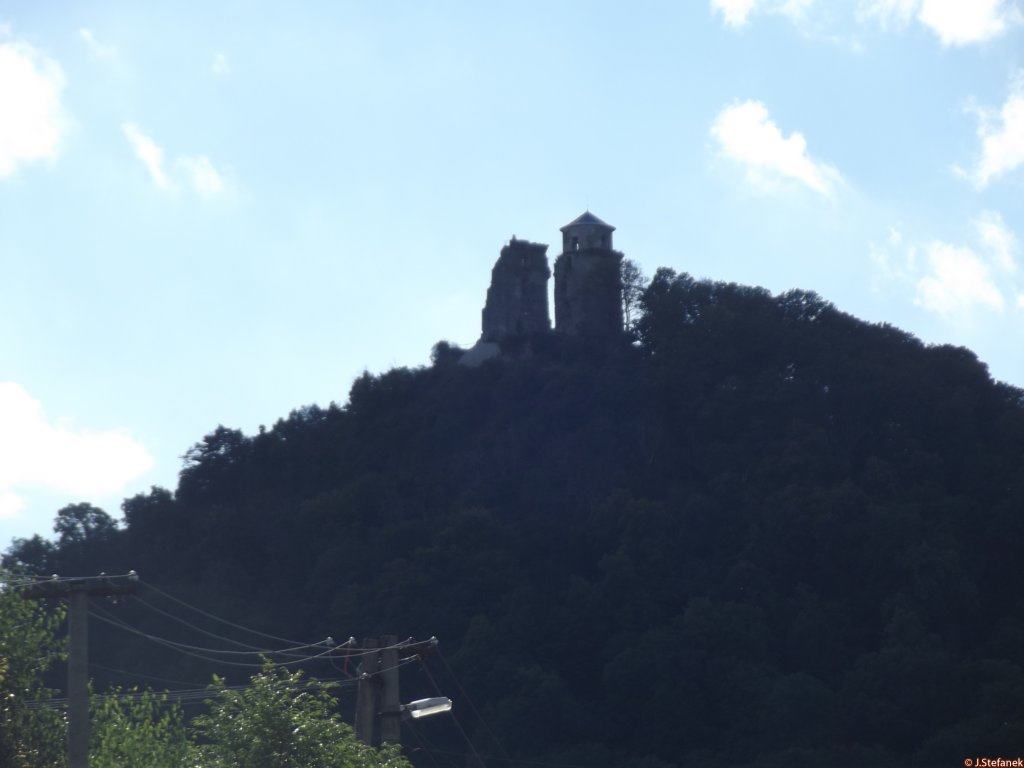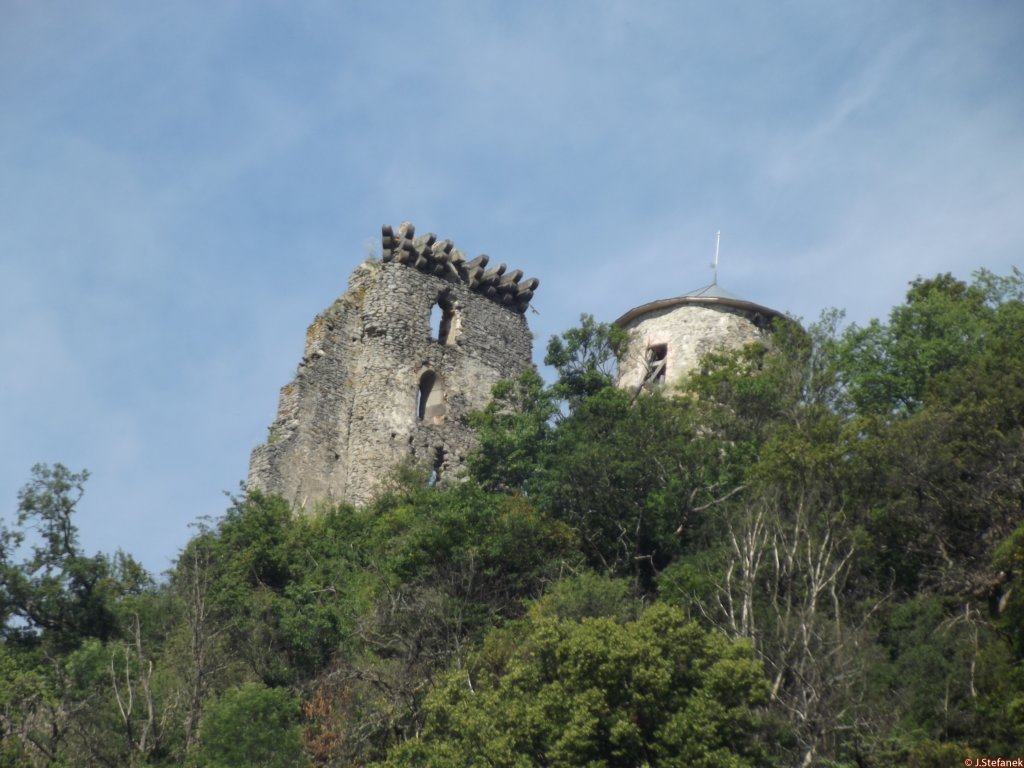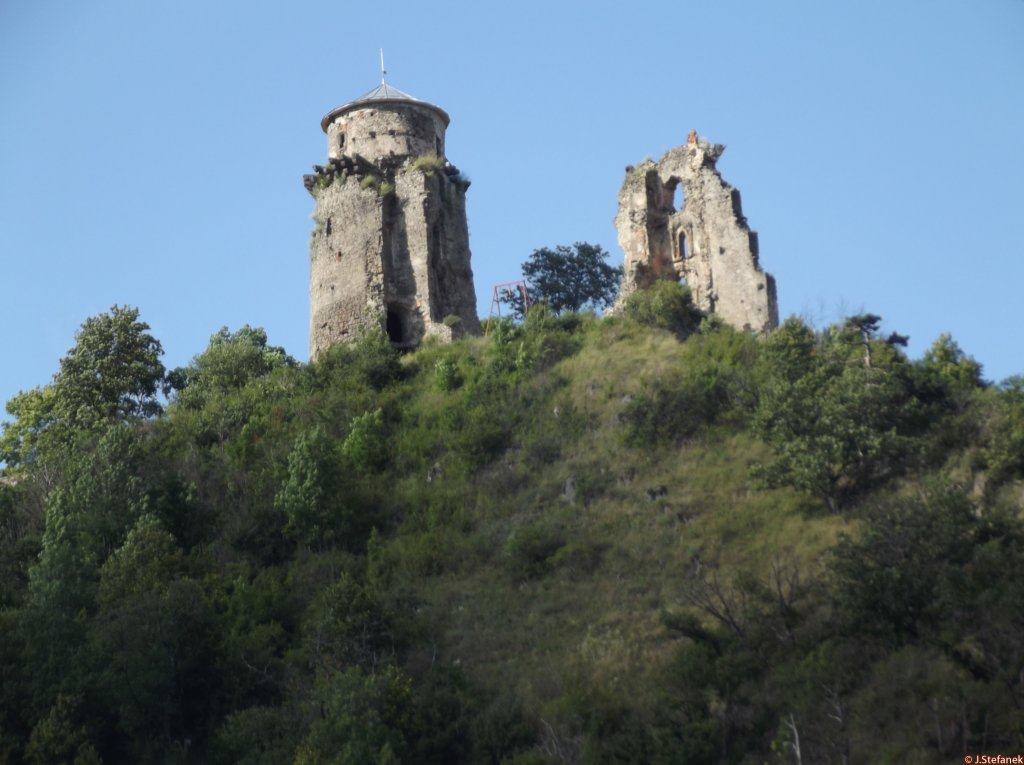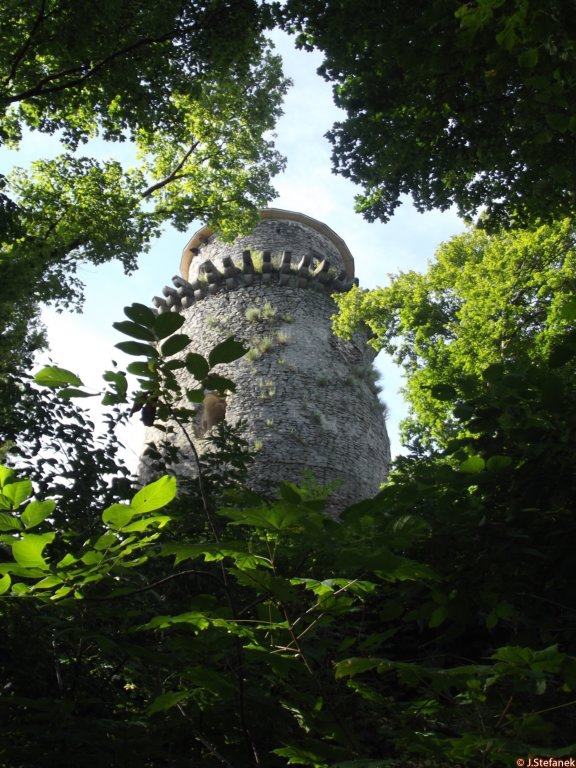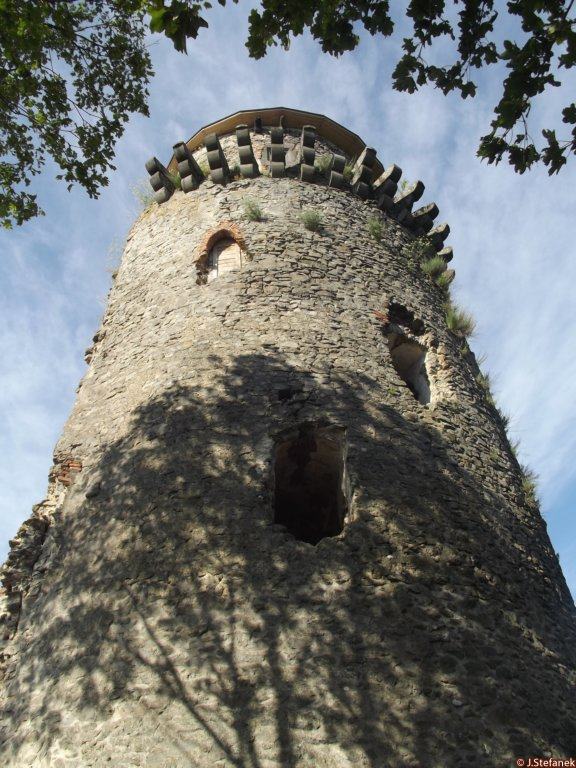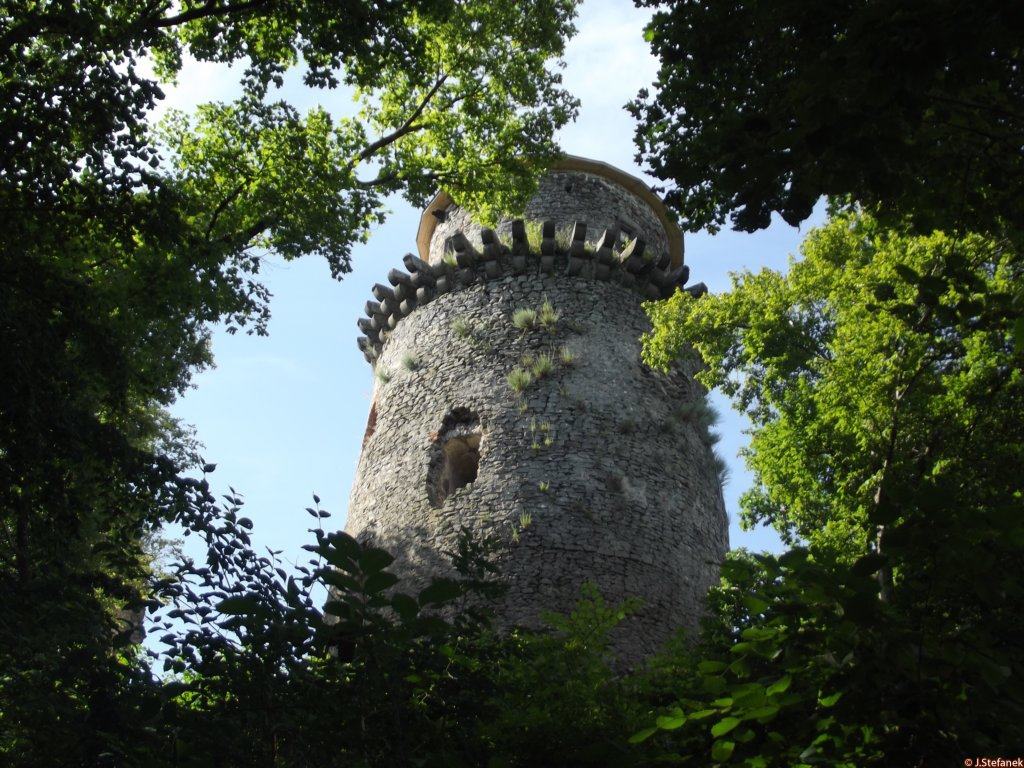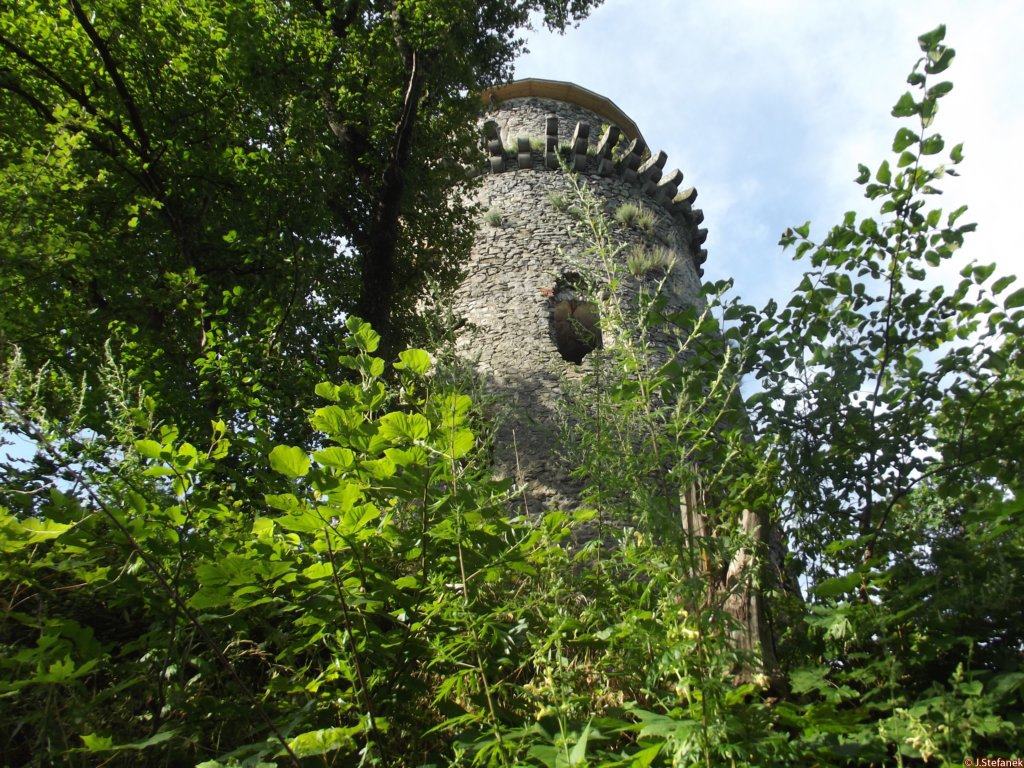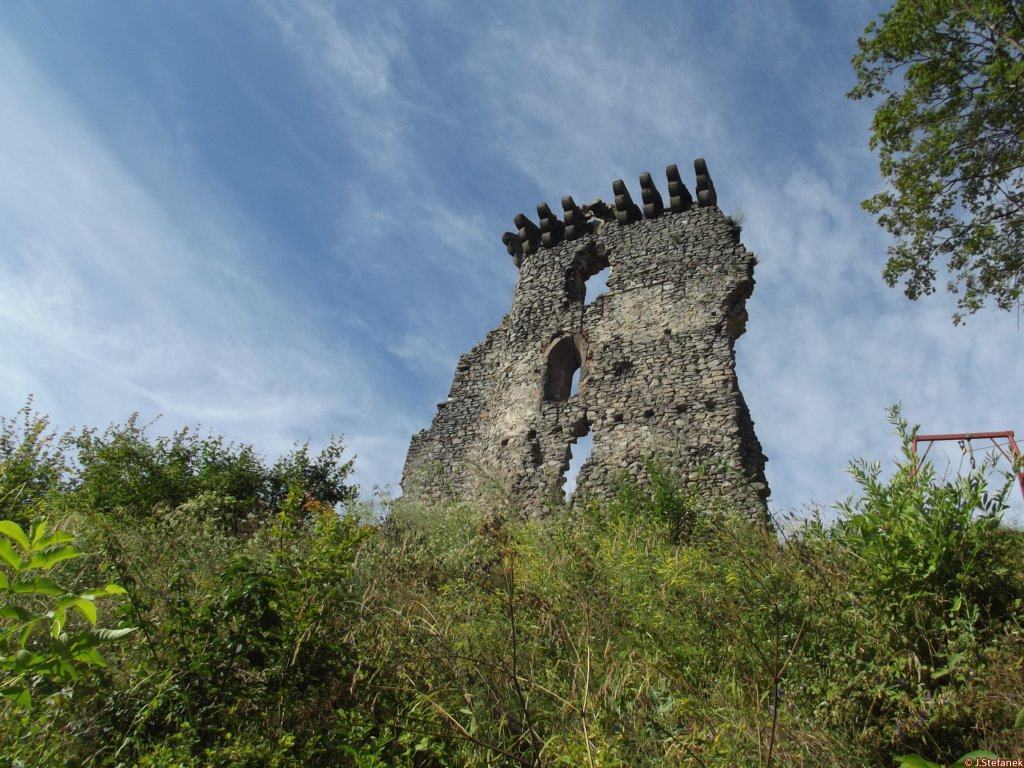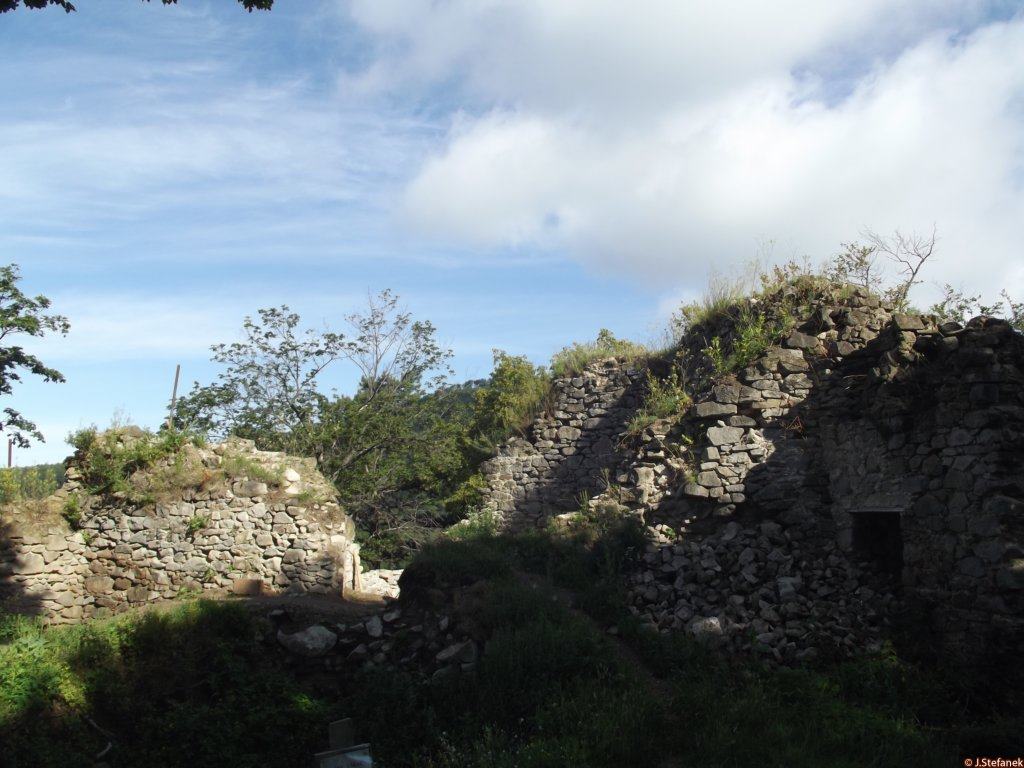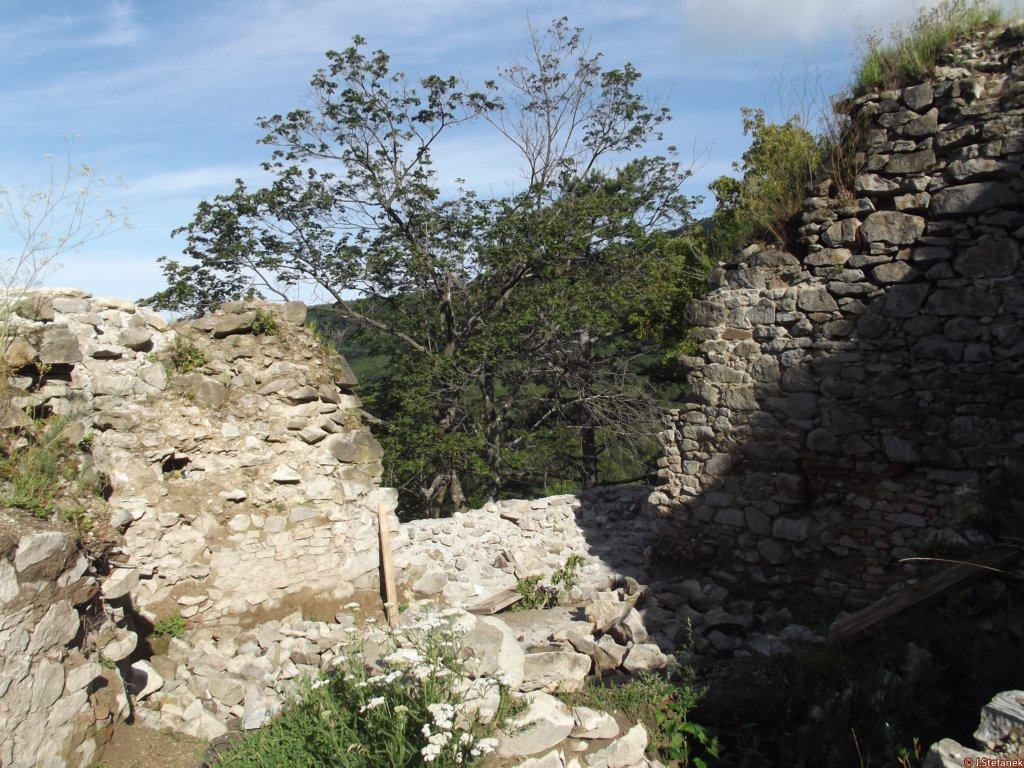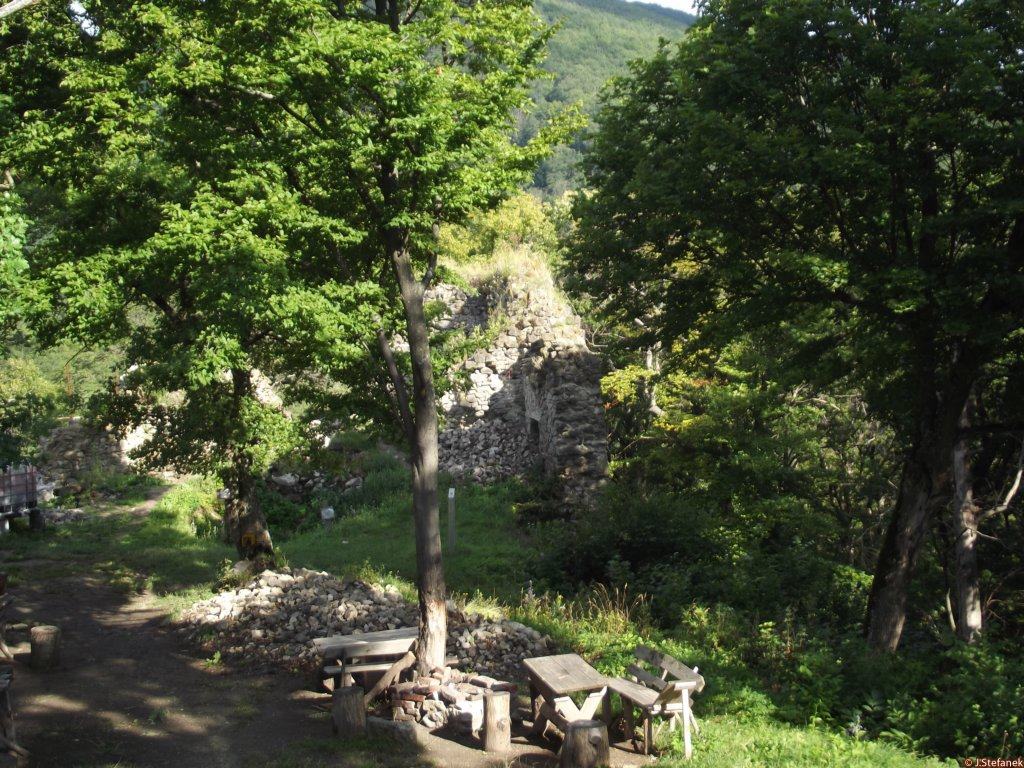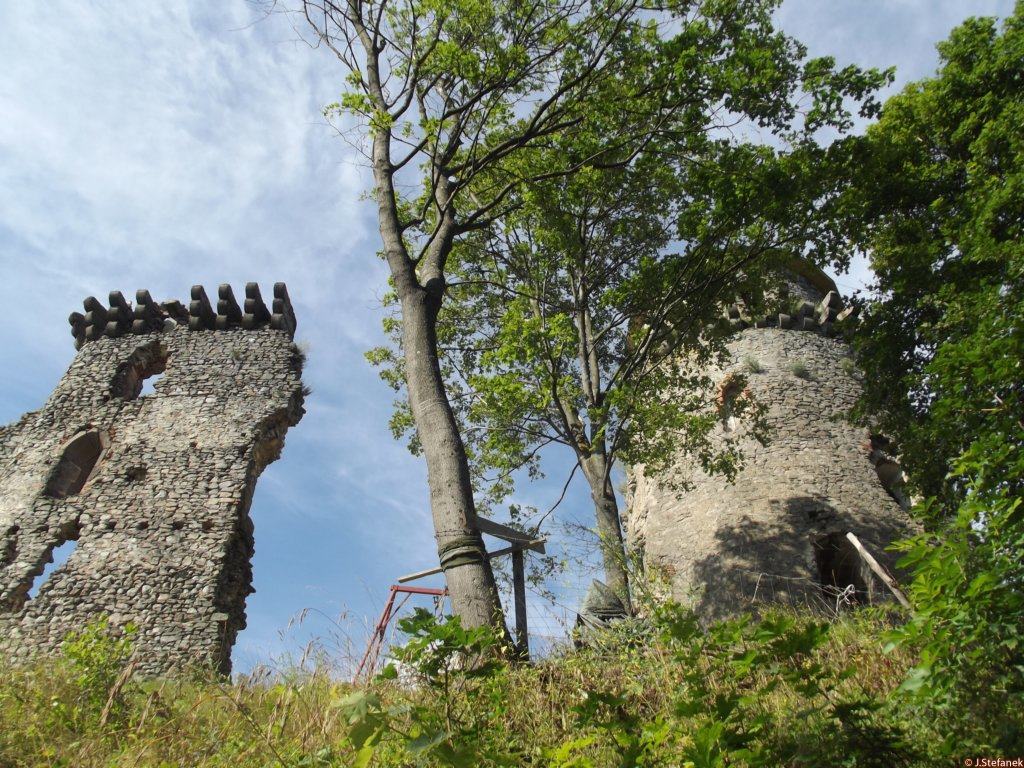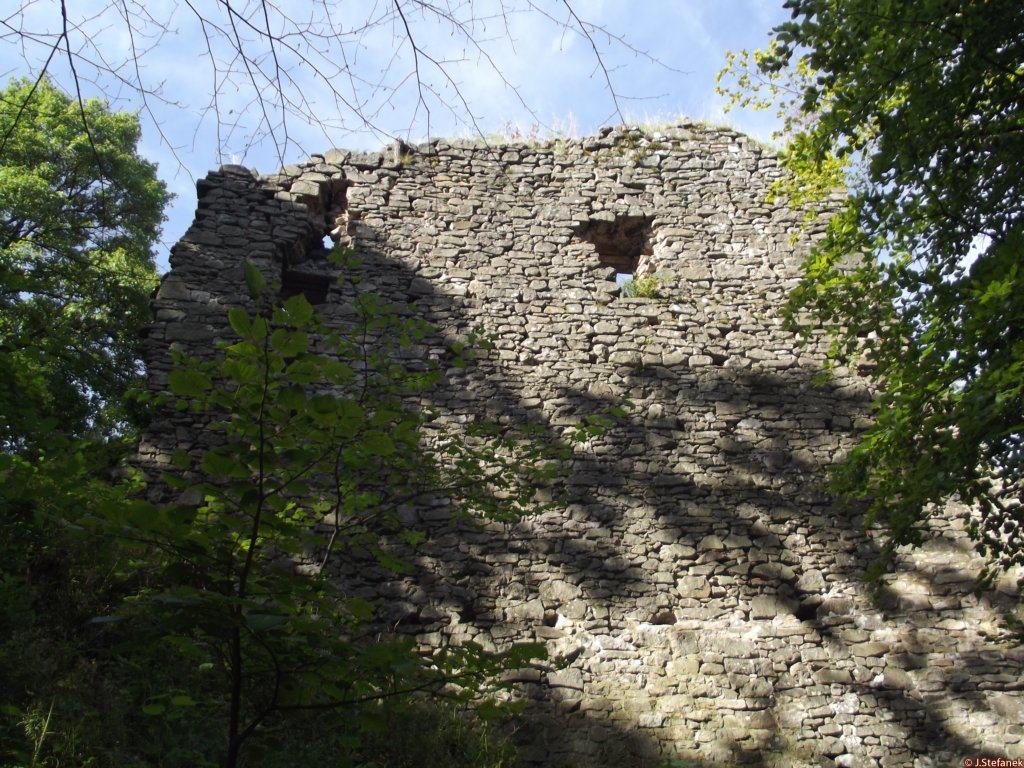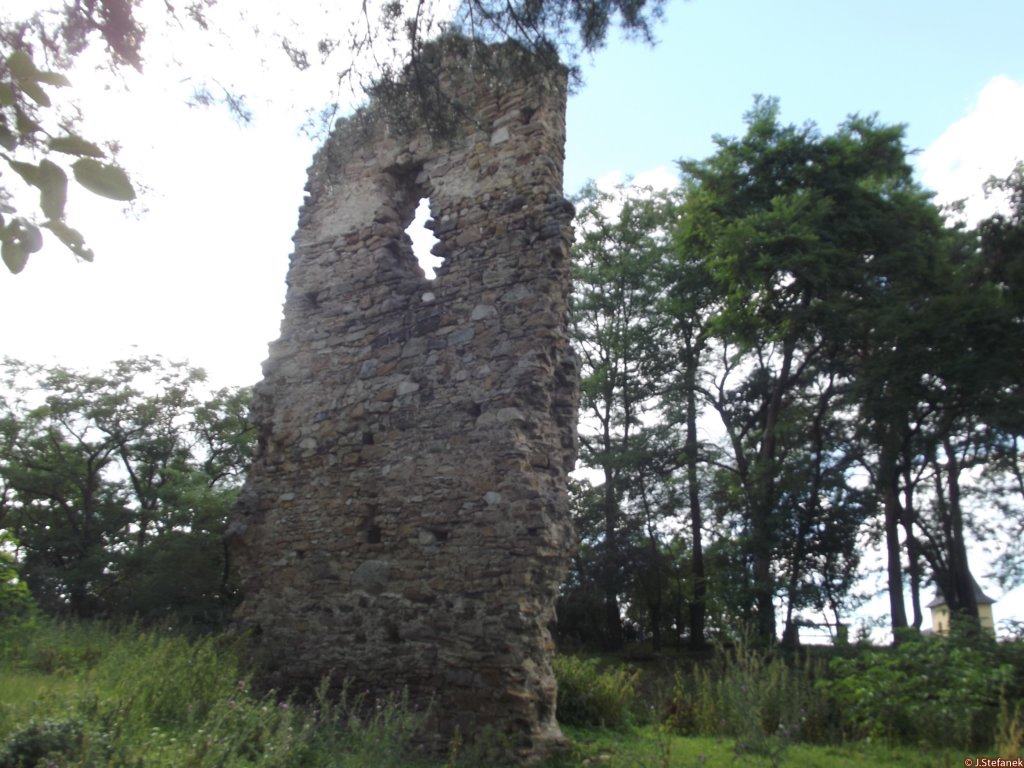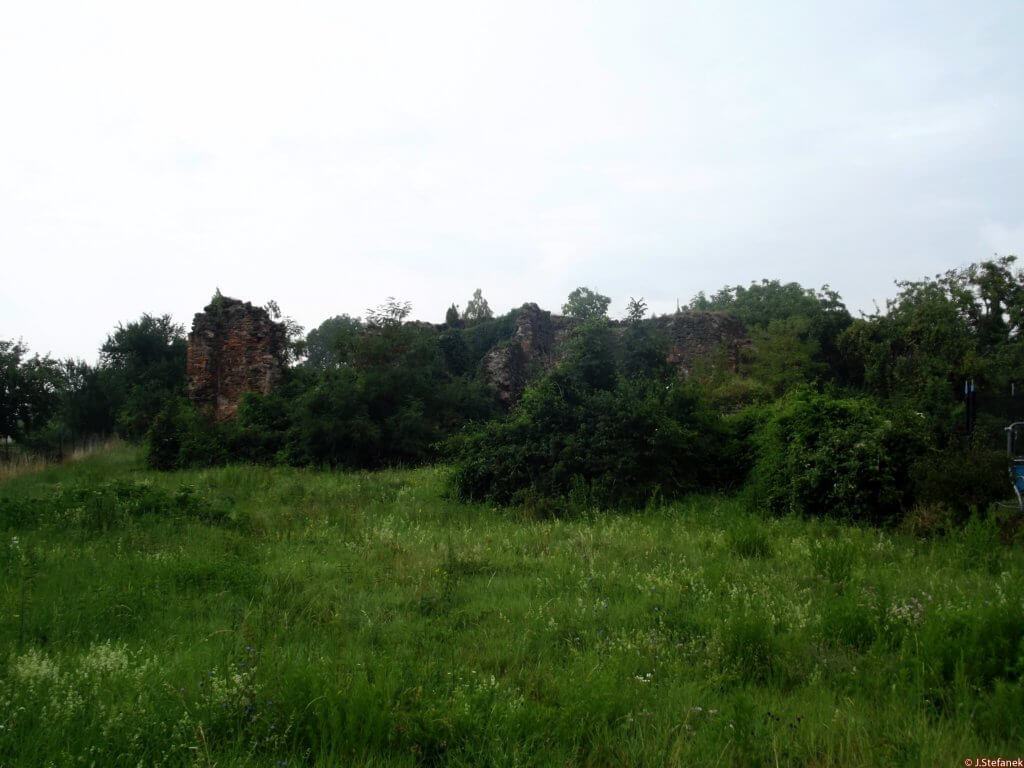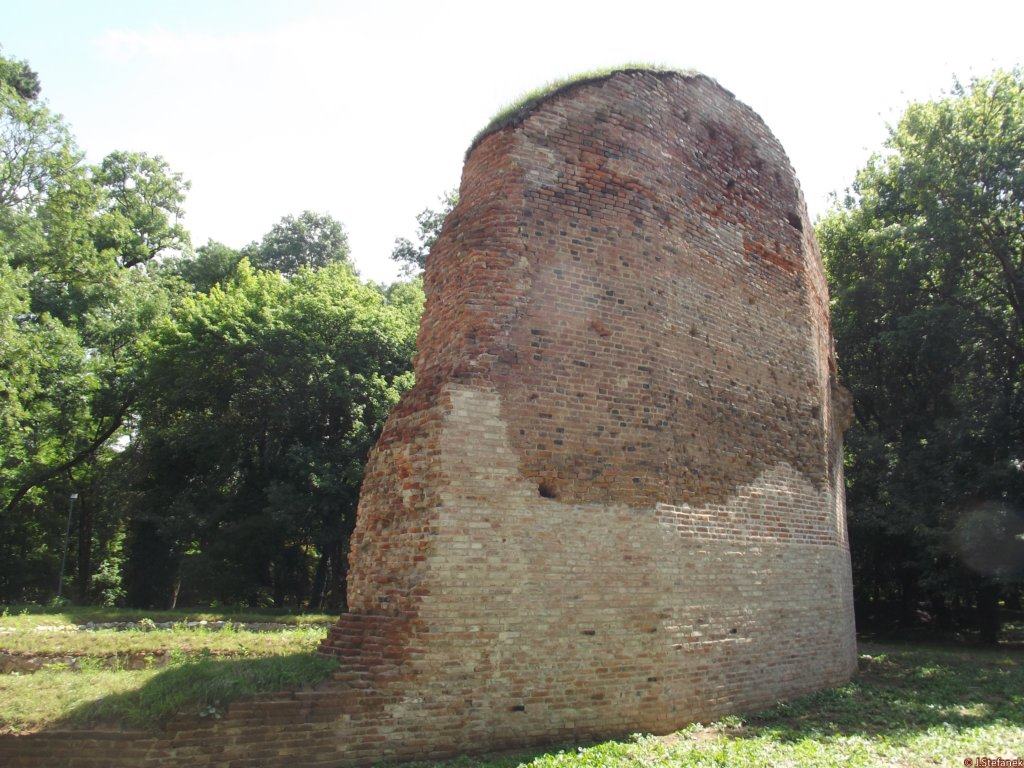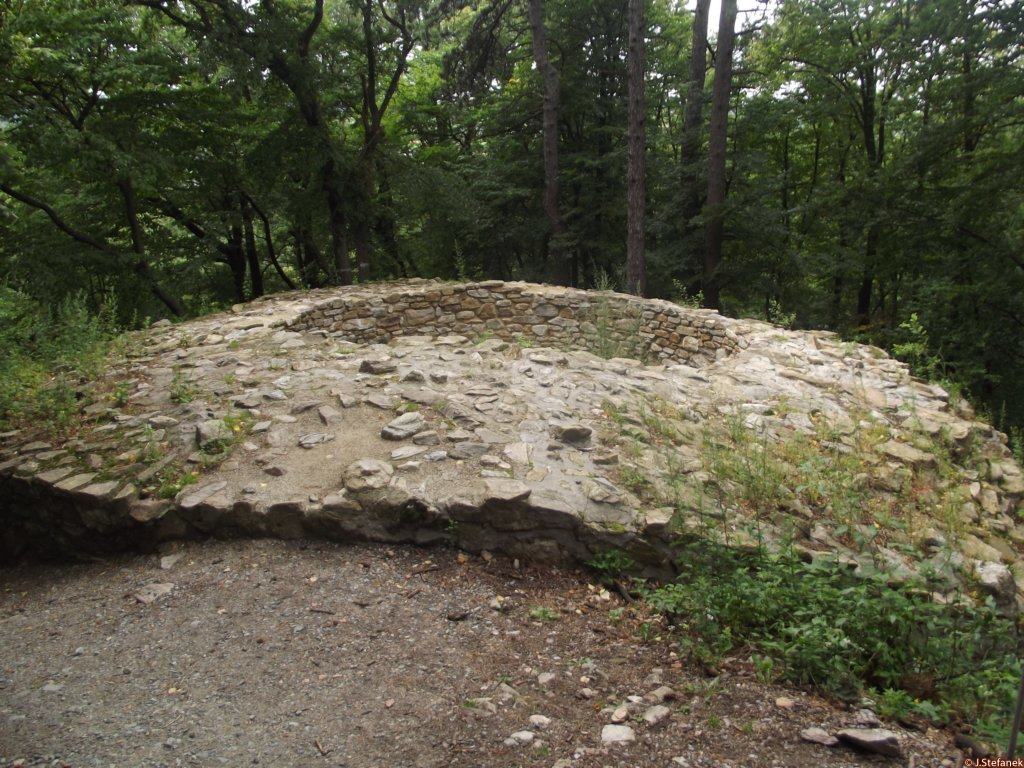Slanec
Slanec Košice county Slovakia
castle ruin
Slanec
Slanec Košický kraj Slovakia
zrúcanina hradu
The ruins of the castle at the top of the andesite cone on the edge of the Slanské vrchy Mountains creates the dominant of the village of Slanec
Zrúcanina hradu na vrchole andezitového kužeľa na okraji Slanských vrchov vytvára dominantu obce Slanec.
Previous names
Salanc, Salis, Zalanch, Scelanch, Zelench, Scelench, Zalanchuara, Salanchuara, Szalánc
Roads
Trasa 1: We'll get to Slanec castle from Hlavná street in the village of Slanec, where we turn to Parková street near the church. We continue, walk past the historic park and immediately after it turn left into a narrow alley that will lead us to a small parking lot near the museum. From there we continue on foot straight to Forgáčová Street, where we turn right. After a while, we come to a turnoff to the forest path on the left (red route), which takes us with a slight ascent to the Slanec crossroads below the castle and from there to the castle.
Trasa 1: K hradu Slanec sa dostaneme z Hlavnej ulice v obci Slanec, kde poblíž kostola odbočíme na ulicu Parkovú. Pokračujeme ďalej, prejdeme popri historickom parku a vzápätí za ním odbočíme vľavo do úzkej uličky, ktorá nás zavedie na malé parkovisko pri múzeu. Odtiaľ pokračujeme peši rovno na Forgáčovu ulicu, kde odbočíme vpravo. Po chvíli prídeme k odbočke na lesnú cestičku vľavo (červená TZT), ktorá nás miernym stúpaním zavedie k rázcestiu Slanec pod hradom a odtiaľ na hrad.
Trasa 2: From the car park in front of the museum, take the same road as in route no. 1. This route will lead us to the same crossroads under the castle, but from the opposite side.
Trasa 2: Z parkoviska pred múzeom rovnakou cestou ako v trase č.1 na Forgáčovu ulicu, kde však pokračujeme stále rovno a na červenú trasu odbočíme až neskôr vľavo. Táto trasa nás privedie k tomu istému rázcestiu pod hradom, len z opačnej strany.
Trasa 3: Access via the red route from Hlavná street before entering the village from the direction of Rákoš. On the left is a turnoff to a field road, where we can park the car and near the well and resting place we continue through a meadow and then on the right through the forest to the Slanec crossroads and from there to the castle. We can significantly shorten this route if we connect to it directly from the village from Pod Hradom Street. We will save about 15 minutes with this shortcut.
Trasa 3: Prístup červenou trasou z Hlavnej ulice ešte pred vstupom do obce zo smeru od Rákoša. Vľavo je odbočka na poľnú cestu, kde môžeme odstaviť auto a blízko studničky a oddychového miesta pokračujeme lúkou a potom vpravo lesom k rázcestiu Slanec a odtiaľ k hradu. Túto trasu si môžeme výrazne skrátiť, ak sa na ňu napojíme priamo z obce z ulice Pod Hradom. Touto skratkou ušetríme asi 15 minút.
Description
>In the ground plan, the castle is a simple rectangular formation, which is narrowed on the northwest side. The choice of the castle type was predetermined by the natural environment, when it was enough to adjust the plateau of the conical hill to become impregnable. Only on the northern side, from where the access road leads to the castle, was a ground fortification with a ditch, the remains of which are still visible today. The first building was a residential, three-storey tower with a defensive walkway. After the reconstruction, the tower was raised by two more floors. The tallest of them had a defensive gallery resting on massive stone cradles. Gradual reconstruction and completion of the castle acquired the character of a palace, which had a chapel on the ground floor.Preserved profile window with columns and leaf decoration on the feet is from the beginning of the 14th century. Near the main tower was added a large circular tower, which had a cantilever gallery at the same height as the palace gallery. Its remains are well preserved to the present day. In the 15th century the castle was extended northwest to the edge of the top plateau. A bastion was placed in the narrowed corner of the hill, guarding the access to the castle. The entrance gothic gate was protected by a drawbridge. At the bastion a 10-meter-deep circular cistern was carved in the rock, walled by massive blocks.
V pôdoryse predstavuje stavba hradu jednoduchý obdĺžnikový útvar, ktorý je na severozápadnej strane lichobežníkovito zúžený. Voľba hradného typu bola predurčená prírodným prostredím, kedy stačilo upraviť plató kužeľovitého kopca, aby sa stal nedobytným. Jedine na severnej strane, odkiaľ vedie k hradu prístupová cesta, bolo urobené zemné opevnenie s priekopou, ktorej zvyšky sú aj v súčasnosti viditeľné. Prvotnou stavbou bola obytná, trojpodlažná veža s obrannou ochodzou. Po prestavbe bola veža vyvýšená o ďalšie dve podlažia. Najvyššie z nich malo obrannú galériu, spočívajúcu na mohutných kamenných krakorcoch. Postupnou prestavbou a dostavbou nadobúda hrad charakter paláca, ktorý mal v prízemí kaplnku.Zachované profilové okno so stĺpikmi a listovým dekorom na pätkách je zo začiatku 14. storočia. Neďaleko hlavnej veže bola pristavaná veľká kruhovitá veža, ktorá mala krakorcovú galériu v rovnakej výške, ako bola palácová galéria. Jej zvyšky sú dobre zachované do súčasnosti. V 15. storočí bol bol hrad rozšírený severozápadným smerom na okraj vrcholnej plošiny. Do zúženého cípu návršia bola vsadená bašta, strážiaca prístup k hradu. Vstupná gotická brána bola chránená padacím mostom. Pri bašte bola v skale vysekaná 10 metrov hlboká kruhová cisterna, obmurovaná masívnymi kvádrami.Hradnú siluetu najcharakteristickejšie vytvára veža Nebojsa. Na hrade stojí do výšky štyroch podlaží oblá útočištná veža. Prvé podlažie, do ktorého sa dá pohodlne vstúpiť po kamennej plošine má ešte strop, ostatné podlažia majú poškodenú drevenú konštrukciu medzipodlaží. Hore na veži je pozostatok strechy. Vedľa bergfritovej veže je múr gotického paláca, ktorý má zachovalé gotické okno kaplnky a gotické nosníky klenby. V skutočnosti to bola obytná veža nazývaná ako Donjon. Pred bergfritovou vežou je obranné predhradie s cisternou a pivnicami.
Plan
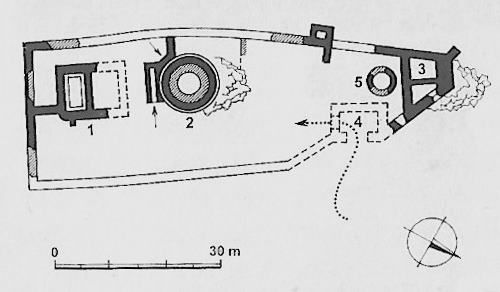
Legend to the ground plan
- 1 - originally a residential prismatic tower
- rebuilt into a Gothic palace
- 2 - round tower
- 3 - watchtower
- 4 - defunct Gothic gate
- 5 - cistern
Legenda k pôdorysu
- 1 - pôvodne obytná hranolová veža
- prestavaná na gotický palác
- 2 - okrúhla veža
- 3 - strážna bašta
- 4 - zaniknutá gotická brána
- 5 - cisterna
History
The medieval castle was built on an older Slavic fort in the 13th century. The initiators of the construction were probably members of the Slaba branch of the Aba family. It was probably David of the Abovites. The first historical mentions are from 1281, when a stone castle with a round tower was already standing. The owner of the castle and the landscape palatine Finta from the Abovce family in 1281 opposed the economic reforms introduced by King Ladislav IV. Kumánsky. Their dispute culminated in a fight under the castle and ended in victory for the king. Although the king succeeded in his plan and the palatine Finta was defeated, the castle remained the property of the abalone branch of the Abovce family for about 50 years.
In 1330, the castle was acquired by Magister Villiam Drugeth, to whom the original owners exchanged the castle estate for four villages in Šarišská stolice. After his death, his brother Mikuláš Drugeth became the owner of the castle. After the death of King Louis I the Great, the castle passed into the hands of the Drugeth family into the ownership of the royal crown. In 1385, a relative of Ľudovít - a king of Naples, Charles of Drače, called Malý, invaded Hungary as part of the battle for the throne. With the generous support of the nobility from the southern capitals of Hungary, he was crowned King of Hungary on December 31, 1385. At the beginning of 1386, Karol Malý donated Slanec Castle and its surroundings to the aristocratic Lossonczy family. Ladislav Lossonczy became the owner of the castle. However, Karol Malý did not rule for a long time, in the same year Alžbeta Kotromaničová's supporters assassinated him.
After the death of Ladislav Lossonczy, his son Dionýz Lossonczy became the owner of the castle. In the middle of the 15th century, when Albert Lossonczy was the owner of the castle, the castle was temporarily occupied by the troops of the Brothers, who remained here until 1458. In the first half of the 15th century, the castle and the village were burned down. Later, the castle became the property of the family of Ladislav III. Lossonczy, who repaired and restored it at the end of the 15th century. In 1552, the last male member of the family - Štefan Lossonczy - died in the battles against the Turks. After his death, his daughter Anna Lossonczy became the owner of the castle. Anna of the Lossonczy family then married Count Sigismund Forgách in 1590, after the death of her second husband, Baron Krištof Ungnad (he was a Hungarian palatine in 1618-1621). After Anna's death in 1595, her husband Sigismund ruled the estate and tried to get Slanec into hereditary possession for his family. This effort ended successfully when in 1601 Emperor Rudolf II. he donated the castle and surrounding property with a deed of donation. The Forgách family fortified the castle.
During the Rákóczi-Thököly uprisings, the castle changed its owner several times and was severely damaged. After the outbreak of the first anti-Habsburg uprising under the leadership of Stefan Bocskaya, the castle was seized by its bastards in 1605, and in later uprisings the castle fell into the hands of the rebels Gabriel Bethlen (1621), resp. insurgents Juraj I. Rákoczi (d. 1644). After Imrich Tököly's armed performance, his Kuruk divisions seized Slanca relatively quickly as early as 1678, but the castle remained in their power for only one year. As the imperial troops approached the castle, the Kurucs set fire to the castle and fled. Shortly afterwards, General Leslie was ordered by Emperor Leopold to completely destroy the castle, which he did.
Slaný Castle fell into disrepair for more than 130 years after the demolition. Life returned to the castle hill in 1815, when the owner of the manor, Jozef Forgách, had the central castle tower (donjon) reconstructed and established a family museum there. After the death of Štefan Forgách (1916), the last member of the family based in the village of Slanec, the museum still existed until 1937. During the Second World War, the castle tower gradually fell into disrepair until it completely burned down in 1945. The wooden roof was restored after the fire and protected the interior of the tower from the weather for many decades, but at the beginning of the 21st century it gradually fell apart due to weather conditions. Since then, the entire ruin has been exposed to the elements, and destruction has gradually taken place, especially in the weakened, unprotected places of the castle. At present, thanks to the civic association Let's Save Slanec Castle, the castle is undergoing reconstruction and, among other things, the castle tower has been restored.
Stredoveký hrad bol postavený na staršom slovanskom hradisku v 13. storočí. Iniciátormi výstavby boli zrejme príslušníci slaneckej vetvy rodu Aba. Pravdepodobne to bol Dávid z rodu Abovcov. Prvé historické zmienky sú z roku 1281, keď už kamenný hrad s okrúhlou vežou stál. Majiteľ hradu a krajinský palatín Finta z rodu Abovcov sa v roku 1281 postavil proti hospodárskym reformám, ktoré zavádzal kráľ Ladislav IV. Kumánsky. Ich spor vyvrcholil v boji pod hradom a skončil víťazstvom kráľa. Kráľovi sa síce jeho zámer vydaril a palatín Finta bol porazený, no hrad ostal ešte na zhruba 50 rokov vlastníctvom slaneckej vetvy Abovcov.
V roku 1330 hrad získal Magister Villiam Drugeth, ktorému pôvodní majitelia vymenili hradné panstvo za štyri dediny v Šarišskej stolici. Po jeho smrti sa majiteľom hradu stáva jeho brat Mikuláš Drugeth. Po smrti kráľa Ľudovíta I. Veľkého prešiel hrad z rúk Drugethovcov do vlastníctva kráľovskej koruny. V roku 1385 vtrhol do Uhorska v rámci bojov o trón Ľudovítov príbuzný – neapolský kráľ Karol z Drače, zvaný Malý. Za výdatnej podpory šľachty z južných stolíc Uhorska bol 31. decembra 1385 korunovaný za uhorského kráľa. Začiatkom roku 1386 daroval Karol Malý hrad Slanec a jeho okolie šľachtickej rodine Lossonczyovcov. Majiteľom hradu sa stal Ladislav Lossonczy. Karol Malý ale dlho nevládol, ešte v tom istom roku prívrženci Alžbety Kotromaničovej na neho spáchali atentát.
Po smrti Ladislava Lossonczyho sa majiteľom hradu stáva jeho syn Dionýz Lossonczy. V polovici 15.storočia, keď bol majiteľom hradu Albert Lossonczy, na čas obsadili hrad vojská Bratríkov, ktorí tu zotrvali do roku 1458. V prvej polovici 15. storočia bol hrad aj s obcou vypálený. Neskôr hrad prešiel do majetku rodiny Ladislava III. Lossonczyho, ktorý ho koncom 15.storočia opravil a reštauroval. V roku 1552 zahynul v bojoch proti Turkom posledný mužský príslušník rodu – Štefan Lossonczy. Po jeho smrti sa majiteľkou hradu stala jeho dcéra Anna Lossonczy. Anna z rodu Lossonczy sa potom v roku 1590, po smrti svojho druhého manžela, baróna Krištofa Ungnada, vydala za grófa Žigmunda Forgácha (v rokoch 1618-1621 bol uhorským palatínom). Po smrti Anny v roku 1595 na panstve vládol jej manžel Žigmund a snažil sa získať Slanec do dedičnej držby pre svoj rod. Toto úsilie skončilo úspešne, keď mu v roku 1601 cisár Rudolf II. donačnou listinou daroval hrad a okolité majetky. Forgáchovci dali hrad opevniť.
Za rákócziovsko-thökölyovských povstaní hrad niekoľko krát menil svojho majiteľa a bol značne poškodený. Po vypuknutí prvého protihabsburského povstania pod vedením Štefana Bocskaya sa hradu v roku 1605 zmocnili jeho hajdúsi a v neskorších povstaniach sa hrad dostal do rúk povstalcov Gabriela Bethlena (r. 1621), resp. povstalcov Juraja I. Rákocziho (r. 1644). Po ozbrojenom vystúpení Imricha Tökölyho sa jeho kurucké oddiely zmocnili Slanca pomerne rýchlo už v roku 1678, no v ich moci hrad ostal iba jeden rok. Keď sa k hradu priblížili cisárske vojská, kuruci hrad podpálili a utiekli. Krátko nato dostal generál Leslie od cisára Leopolda príkaz hrad úplne zničiť, čo sa aj stalo.
Slanský hrad po zbúraní chátral viac ako 130 rokov. Život sa na hradný kopec vrátil v roku 1815, kedy dal majiteľ panstva Jozef Forgách zrekonštruovať centrálnu hradnú vežu (donjon) a zriadil v nej rodové múzeum. Po smrti Štefana Forgácha (r. 1916), posledného člena rodu sídliaceho v obci Slanec, múzeum existovalo ešte do roku 1937. Počas druhej svetovej vojny začala hradná veža postupne chátrať, až kým v roku 1945 úplne nevyhorela. Drevená strecha bola po požiari obnovená a chránila ešte dlhé desaťročia interiér veže pred počasím, no začiatkom 21. storočia sa postupne vplyvom poveternostných podmienok úplne rozpadla. Od tej doby bola celá zrúcanina vystavená prírodným živlom a postupne dochádzalo k deštrukcii, hlavne na oslabených, nechránených miestach hradu.
V súčasnosti vďaka občianskemu združeniu Zachráňme hrad Slanec na hrade prebieha rekonštrukcia a okrem iného bola obnovená aj hradná veža.
Myths and legends
The rumor says
Gentlemen, dissatisfied with the young ruler, plotted a revolt. Count Forgach broke into the queen's bedroom on a spare summer night with a dagger in his hand, but she, awakened by a rumble, jumped out of bed. The man, dazzled by the beauty of nudity, became the savior of the executioner. As a reward, Slanec received the image of the queen as he had seen her that fateful night.
The scribe is the murderer
The castle scribe Anton once spoke to the noble lord Lossonczy to marry the beautiful Klára Báthora. He loved her himself and at least he wanted to have her close. Later, he also helped to cool the relationship between the spouses. Klára confessed his love and murdered his master. The scribe escaped from the castle and the suspicion fell on a woman who had been sentenced to a long prison term in the murdered man's room. Years later, the scribe returned to the castle disguised as a monk. Klára asked for a night meeting by the lake, where he wanted to get her. At that moment, a big storm broke down and the frightened Klára jumped into the lake and drowned in its turbulent waters. The scribe also went badly, who was subsequently struck by lightning from the sky.
Povráva sa
Páni, nespokojní s mladou vladárkou, zosnovali vzburu. Gróf Forgách v spare letnej noci s dýkou v ruke vnikol do spálne kráľovnej, no ona zobudená šramotom vyskočila z lôžka. Muž, oslnený krásou nahotinky, z kata sa stal jej záchrancom. Za odmenu dostal Slanec a do znaku obraz kráľovnej, tak, ako ju zočil onej osudnej noci.
Pisár vrahom
Hradný pisár Anton raz nahovoril vznešeného pána Lossonczyho, aby sa oženil s krásnou Klárou Báthory. Sám ju totiž miloval a aspoň takto ju chcel mať nablízku. Neskôr sa pričinil aj o ochladnutie vzťahov medzi manželmi. Kláre vyznal lásku a svojho pána zavraždil. Pisár z hradu ušiel a podozrenie padlo na ženu, ktorá bola odsúdená na dlhotrvajúce väzenie v izbe zavraždeného. Po rokoch sa pisár vrátil na hrad preoblečený za mnícha. Kláru požiadal o nočnú schôdzku pri jazere, kde sa jej chcel zmocniť. V tom momente sa strhla veľká búrka a vystrašená Klára skočila do jazera a v jeho rozbúrených vodách sa utopila. Zle obišiel aj pisár, ktorého následne zasiahol blesk z neba.
Useful information
The ruins are freely accessible
Zrúcanina je voľne prístupná
Nearby castles
